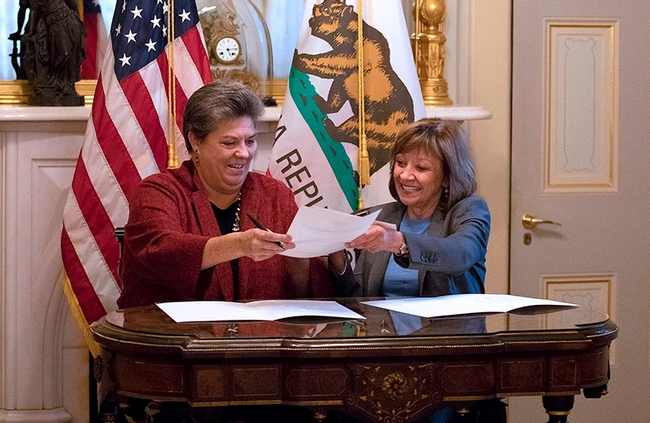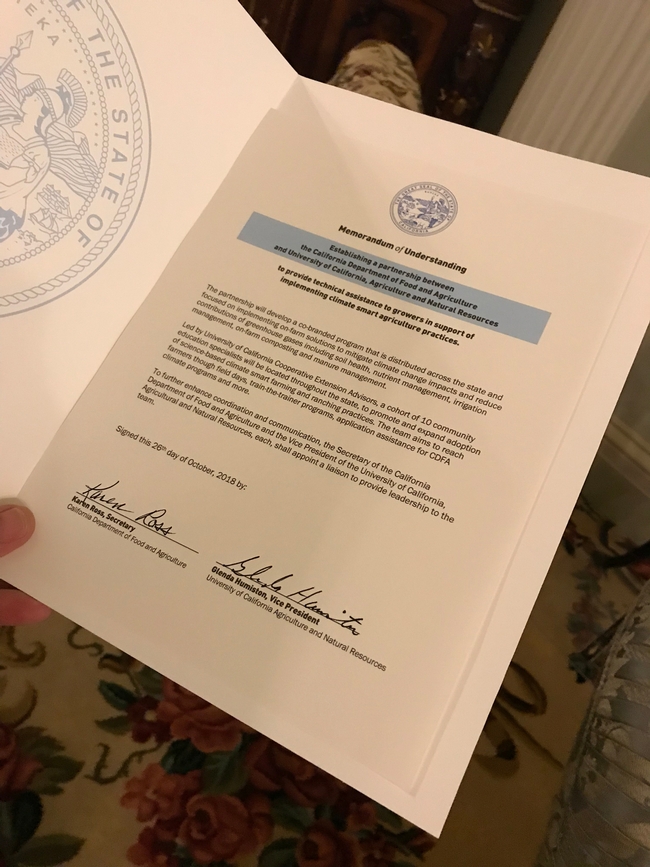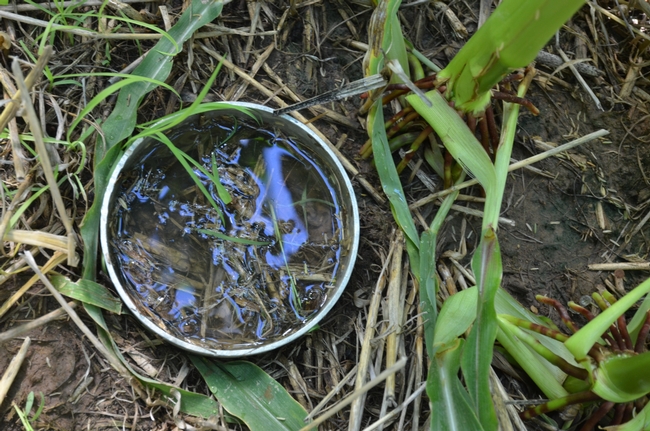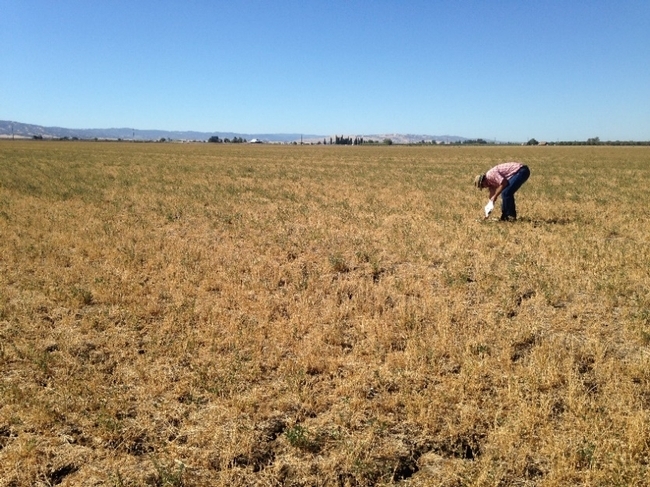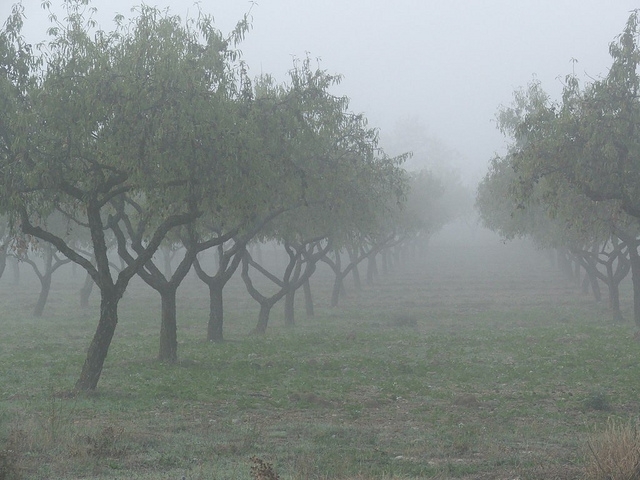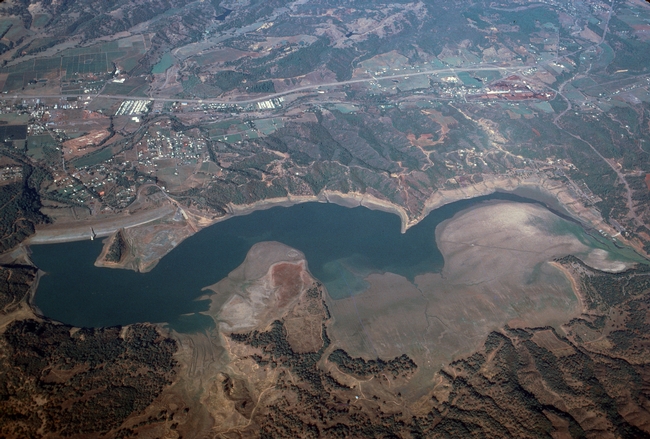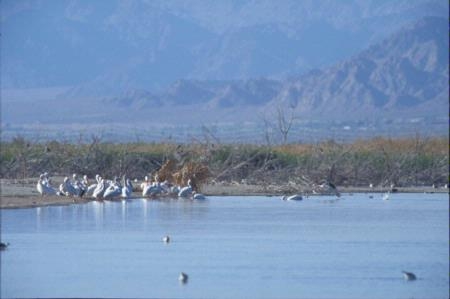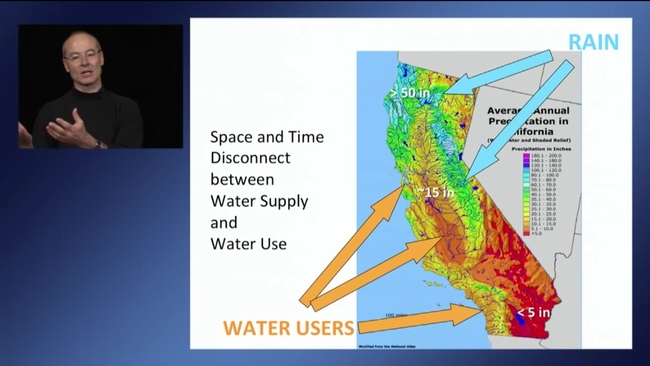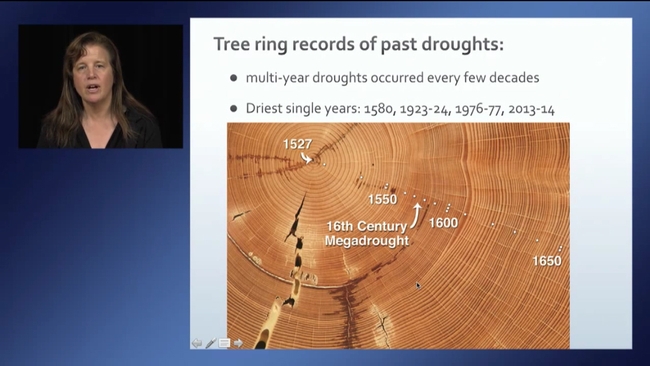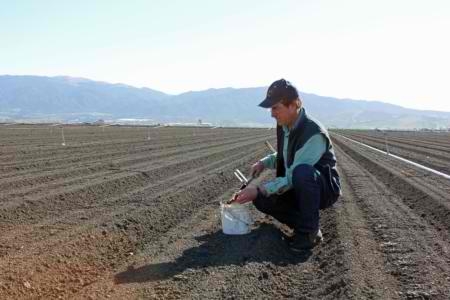Posts Tagged: Doug Parker
CDFA and UC ANR join forces to advance climate-smart agriculture in California
California Secretary of Agriculture Karen Ross and UC Agriculture and Natural Resources vice president Glenda Humiston signed a memorandum of understanding in Sacramento Oct. 26 to initiate a new partnership to advance climate-smart agriculture in California.
This partnership will provide $1.1 million to hire 10 UC Cooperative Extension community education specialists who will be deployed to 10 counties statewide to assist and encourage farmers to participate in CDFA programs aimed at increasing adoption of smart farming and ranching practices.
“Agriculture is an important part of the climate solution,” Ross said. “This funding enables CDFA and UC ANR to partner with farmers to scale-up climate smart agricultural practices.”
The new program is funded by California Climate Investments dollars through the Strategic Growth Council (SGC),
“Farmers and ranchers are key to carbon sequestration and a sustainable California,” said SGC chair Ken Alex. “The Strategic Growth Council is pleased to fund this partnership for smart agricultural practices.”
The partnership is focused on implementing on-farm solutions to improve soil health, nutrient management, irrigation management, on-farm composting and manure management – smart farming practices that reduce greenhouse gas emissions into the atmosphere.
- State Water Efficiency and Enhancement Program
- Healthy Soils Program
- Alternative Manure Management Program
“This new joint effort reflects our commitment to extending research-supported solutions to our farming community so they have the information and tools they need to make climate-smart decisions,” Humiston said. “It also demonstrates our shared goal of promoting new practices that are grounded in science.”
The 10 new education specialists will serve in Mendocino, Glenn, Yolo, San Joaquin, Merced, Kern, Imperial, San Diego, San Luis Obispo and Santa Cruz counties.
Three UCCE advisors will mentor and assist the new educators: water quality and management advisor Laurent Ahiablame, based in San Diego County; area dairy advisor Betsy Karle, based in Glenn County; and irrigation and cotton advisor Dan Munk, based in Fresno County.
In addition to working with the new educators, the UCCE advisors conduct research on farming and ranching practices that boost efficiency and protect the climate, therefore serving as a conduit between discovery and implementation.
“This is a great opportunity to really support growers find the right balance between food production and effective management of natural resources,” Ahiablame said. “With the 10 community education specialists we will be one step closer to the producers across the state. I look forward to the opportunity to mentor these specialists, who in turn will be making direct impacts on the community.”
Karle said she was interested in participating in the program as a way to encourage dairy operators to try practices they are interested in but consider too costly.
“I've worked here locally with dairy producers who wanted to implement practices but need financial assistance in order to make it feasible,” Karle said. “They need assistance in the grant application process and technical support to make changes on their farms.”
Doug Parker, director of the UC California Institute for Water Resources, is the UC ANR point of contact and liaison with CDFA. To contact Parker, email doug.parker@ucop.edu.
Drought tips available for farmers
Drought strategies for managing alfalfa and many other crops are available free from UC Agriculture and Natural Resources. As California endures a fourth year of drought and ever-tightening water supplies, water-management strategies have become even more critical to farmers.
To help farmers make the best use of the water they have available, a series of new and updated drought tips fact sheets has been developed by UC ANR scientists and funded by the California Department of Water Resources.
“These drought tips provide irrigation management recommendations for a broad range of agricultural crops and under different water supply conditions,” said Daniele Zaccaria, UC ANR Cooperative Extension agricultural water management specialist at UC Davis and major organizer of the drought tip series. “The information in these tips will be of practical use for growers and other water-related stakeholders now and into the future as our agricultural community continues to adapt to climate variability and to a changing water supply situation.”
UC ANR scientists have identified best management practices for a wide range of annual and permanent crops and irrigation systems and methods during the drought. In the drought tips series, they also give advice for managing soil salinity and using shallow groundwater for irrigating crops. For beef cattle, they provide recommendations for culling herds and feeding to supplement grazing.
The following drought tips are currently available for free download at http://ucanr.edu/drought-tips:
- Drought strategies for alfalfa
- Drought management for California almonds
- Use of shallow groundwater for crop production
- Drought strategies for walnuts
- Fog contribution to crop water use
- Reclaiming Saline, Sodic and Saline-Sodic Soils
Decades of UC ANR research underlie the information contained in the drought tips. In the 1970s and again in the 1990s, UC ANR partnered with DWR to develop a series of drought management fact sheets.
“DWR has worked with UC ANR to update the drought tips and make sure the latest and best information on water management is available to growers,” said Peter Brostrom, DWR Water Use Efficiency Section Manager.
The California Institute for Water Resources, which coordinates water-related research and extension education across the 10 UC campuses and UCANR, has the drought tips and more drought resources online at http://ciwr.ucanr.edu.
“Even if El Niño brings rain this fall, water scarcity will continue to impact California farmers,” said Doug Parker, director of UC ANR's California Institute for Water Resources. “As climate change continues to reduce the average annual snowpack, it is likely that droughts in California will become more frequent and severe in the years to come.”
UC ANR's California Institute for Water Resources and the California Department of Water Resources also offer drought-related information in a series of videos. Water experts from UC and other agencies and institutions have recorded presentations on high-priority drought topics. Currently 38 videos can be accessed for free on computers and mobile devices at http://ucanr.edu/insights.
UC Agriculture and Natural Resources researchers and educators draw on local expertise to conduct agricultural, environmental, economic, youth development and nutrition research that helps California thrive. Learn more at ucanr.edu
From fracking to water affordability, UC takes on new water-related research
Which California communities are more likely to vote down hydraulic fracturing? Are efforts to make safe, affordable drinking water more accessible working? These are among the questions University of California scientists are trying to answer with six new research projects funded by the UC Agriculture and Natural Resources' California Institute for Water Resources.
High-volume hydraulic fracturing, or fracking, a form of natural gas and oil extraction, is water-intensive and could exacerbate water stress. Gwen Arnold, professor in the Department of Environmental Science and Policy at UC Davis, is examining efforts to locally restrict high-volume hydraulic fracturing.
“There's a lot of concern over water pollution and water use in communities,” said Doug Parker, UC ANR California Institute for Water Resources director. “We're looking at the characteristics of communities that have voted on measures to restrict the practice of fracking, both where the measures have failed and where they've passed.”
Parker expects that people on either side of the issue will be able to use the study's finding to better understand differing viewpoints. Decision-makers who may be contemplating policy action on fracking will also benefit from seeing the range of relevant policies passed by other jurisdictions and the conditions that appear to favor or discourage adoption of the policies.
Another research project is assessing the Integrated Regional Water Management approach to address the lack of safe and affordable water in disadvantaged communities throughout the state. In 2011, the California Department of Water Resources funded seven pilot projects to develop models for improving water supplies for these communities.
“We want to take a look at how well Integrated Regional Water Management worked, whether it is meeting the needs of providing safe, affordable drinking water,” Parker said.
Jonathan London, professor in the Department of Human Ecology and director of the Center for Regional Change at UC Davis, and Carolina Balazs, UC presidential postdoctoral research fellow at UC Davis, are evaluating the impact of those efforts in Inyo-Mono counties, Santa Cruz, Los Angeles County, Kings Basin, North Coast, Imperial Valley and Coachella Valley.
- Roya Bahreini, professor in the Department of Environmental Sciences at UC Riverside, is looking at the relationship between water management and air quality in the Salton Sea region of southern California, where low water levels are leading to increased dust from the dry lakebed.
- Igor Lacan, UC ANR Cooperative Extension advisor in San Mateo-San Francisco counties, is investigating the performance of trees used in streetside stormwater management facilities, which are increasingly common in cities across California as communities look for ways to increase groundwater infiltration.
- Bruce Linquist, UC ANR Cooperative Extension specialist in the Department of Plant Sciences UC Davis, is quantifying methylmercury loads from rice fields to determine whether they may be of concern.
- Clarissa Nobile, professor in the School of Natural Sciences at UC Merced is using a high-tech metagenomic approach to research a potential problem for groundwater wells across the state: biofouling, which has the potential to be a costly challenge.
Learn more about these and other California Institute for Water Resources research projects by visiting http://ciwr.ucanr.edu/CIWR_Making_a_difference.
The California Institute for Water Resources integrates California's research, extension, and education programs to develop research-based solutions to the state's water resource challenges. An initiative to maintain and enhance healthy families and communities is part of the UC Agriculture and Natural Resources Strategic Vision 2025.
Too wet outside to work? Watch a drought video
Rain has begun falling, but California continues to operate under severe water scarcity from low precipitation over the past three years.
“California will need about 150 percent of normal rainfall this winter to end the drought,” said Doug Parker, director of UC California Institute of Water Resources. “Although the rains have come, we can't afford to let our attention drift away from carefully managing our water supply.”
The UC California Institute of Water Resources, with support from the California Department of Water Resources, has recorded presentations by scientists in the UC system and other organizations on a variety of topics related to water management and drought. “Insights: Water and Drought Online Seminar Series” is accessible by computer or mobile device.
The online seminars enable UC Cooperative Extension and the other scientists to share their knowledge with a larger audience than those who can attend meetings in person, said Daniele Zaccaria, UC Cooperative Extension specialist in agricultural water management in the Department of Land, Air and Water Resources at UC Davis.
“Farmers, landscape professionals, land managers, irrigation consultants, resource managers from water districts and others can view the half-hour video presentations on YouTube whenever it is convenient for them, obtaining science-based information that stems from applied research conducted by several scientists over the last 10 to 15 years,” said Zaccaria, who coordinates the speaker series.
Topics include drought impacts on natural resources, drought preparedness, water management in urban landscapes during a drought and crop management with limited water.
Currently 39 videos addressing drought and water management in different settings are available, and more talks will be added in the coming months. The videos are also being used by Cooperative Extension in other states and have been viewed hundreds of times. “Groundwater and surface water interactions under water shortage,” by Thomas Harter, UC Cooperative Extension specialist in the Department of Land, Air and Water Resources at UC Davis, has been viewed nearly 1,400 times and “Climate change and paleoclimatology: 2013/2014 in perspective” by Lynn Ingram, professor in the Department of Earth and Planetary Science at UC Berkeley, has been more than 800 times.
The following titles have recently been added:
Water resources management in the Pajaro Valley, California
Brian Lockwood, senior hydrologist, Pajaro Valley Water Management Agency
Managing corn under California's drought conditions
Mark Lundy, UC Cooperative Extension advisor in Sutter, Yuba and Glenn counties
Droughts, climate change, and dams: Reconciling a future for California's native inland fishes
Peter Moyle, professor in the Department of Wildlife, Fish & Conservation Biology at UC Davis
Managing landscapes on limited water
Loren Oki, UC Cooperative Extension specialist in the Department of Plant Sciences at UC Davis
Drought - An insidious stress on wildlife
Greg Giusti, UC Cooperative Extension advisor, forests and wildland ecology in Mendocino County
Agricultural water management practices under limited water supply: Lessons from recent droughts
James E. Ayars, agricultural engineer, USDA-ARS
Soil moisture monitoring and utilization during a drought
Dan Munk, UC Cooperative Extension advisor, irrigation, soils and cotton in Fresno County
Land subsidence along the Delta-Mendota Canal and neighboring areas
Michelle Sneed, California Water Science Center, US Geological Survey
How to save water and beautify your landscape ... the sustainable way
Janet Hartin, UC Cooperative Extension advisor, environmental horticulture in San Bernardino and Los Angeles counties
Efficient citrus irrigation
Blake Sanden, UC Cooperative Extension advisor, irrigation and soils in Kern County
Using agroecological practices to enhance the resilience of organic farms to drought
Miguel A. Altieri, professor in the Department of Environmental Science, Policy and Management, UC Berkeley
The drought videos are available at http://ucanr.edu/insights and https://www.youtube.com/UCANR.
UC ANR to train crop advisers in nitrogen management
UC ANR scientists are working with the California Department of Food and Agriculture to develop a curriculum and certification program to protect water quality, as recommended by the State Water Resources Control Board. The classes will begin in January 2014.
Last week (Feb. 20) the State Water Resources Control Board released its recommendations to the Legislature for addressing nitrate in groundwater.
The recommendations are based on a UC Davis study commissioned by the water board and released last March titled “Addressing Nitrate in California's Drinking Water,” which focused on the Tulare Lake Basin of the San Joaquin Valley and the Salinas Valley in Monterey County.
“While we know that farmers have already begun employing techniques to reduce the amount of nitrogen fertilizer that can ultimately end up in our groundwater, we also know that there are additional actions that can be taken,” said Doug Parker, director of UC’s California Institute for Water Resources and leader for the UC Agriculture and Natural Resources water strategic initiative.
“In our training for certified crop advisers, we will apply the latest UC research to refine their methods for helping farmers manage nitrogen more effectively.” Parker said.
Plants need nitrogen to grow, but nutrients that are not used by the crop may move below the root zone. Nitrate, a byproduct of nitrogen, may infiltrate to groundwater used for drinking water.
For other examples of UC ANR research and extension projects under way to ensure that all Californians have access to safe drinking water and that the state’s farmers can grow enough food to help meet the world’s increasing demand, please visit http://ucanr.edu/News/Healthy_crops,_safe_water.

